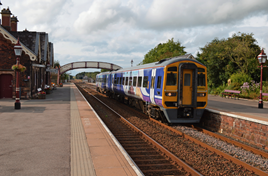It is estimated that 230 permanent piles will be needed in total, laid out in two rows - 130 on the river side and 100 on the cliff side. They will be 660mm in diameter and formed of reinforced concrete protected by steel outer casings. Their overall depth will be between 18 and 20 metres, of which the bottom 5.5m-7.5m will be encased in bedrock. Some 3,600 tonnes of concrete will need to be poured into the piles once they are in position.
The next stage will be to construct the vast concrete slab upon which the formation will sit. This will be 12m wide, 75m long and 3.15m deep, comprising 2,700 tonnes of concrete. The structure will then be buried in earth and the tracks put back on top.
Although the casings for the piles will be brought in by rail from Carlisle Kingmoor Yard, this staggering amount of concrete will need to be brought in by road on concrete mixers, and from December three or four wagonloads per day are set to arrive on site. Middleton says this is for efficiency, as it reduces the transit time between when the concrete is mixed and when it can be poured.
“We lose time and risk quality if we bring in material by road or rail and then mix it on site. The key thing now is getting the main piles in the ground, and then another assessment will be made in November when the first piles have gone in. When we’ve got a good idea of how long the first lot take, we will have a firmer idea of the final completion date.
“All of the other stuff like trackwork and signalling does not affect the critical path much, and even allowing for the weather we think we’ll be done by March.
“After that we will be on site for the re-profiling and slopework until the end of 2017. We need to put rock armour into the river once the salmon spawning season finishes, and then replant trees across the entire area, which will further stabilise the bank.”
Just before it’s time to leave, RAIL is beckoned to an area of ground upon which the excavator sits. Middleton and Monkhouse explain the hidden secrets of the Eden Brows trackbed that were only properly revealed once digging had begun.
Just below the ballast, clear strata can be discerned, made up of loose rubble and then sand. Eden Brows was the site of a large landslip during construction of the line in the early 1870s (see panel, page 80), with little known about the quality of the repairs made then. But it can quickly be deduced, without the need for a degree in soil mechanics, that the ledge here has been quickly patched up using materials excavated from nearby cuttings and tunnels - confirming suspicions that this was an historic weak spot and perhaps even an accident waiting to happen. These are crude measures by today’s standards, perhaps, but from a Victorian age before lasers, pile drivers and reinforced concrete.
Once complete, the buried structure at Eden Brows will offer little visible clue to the size of the task at hand. And following the re-openings at Lamington Viaduct and the Dover Sea Wall earlier this year, it remains until March the sole outstanding serious casualty of the 2015-16 winter storms.
But it’s been a battle all the same, and another fine victory for the S&C, which all being well can now be enjoyed for many more generations to come.
















Login to comment
Comments
No comments have been made yet.